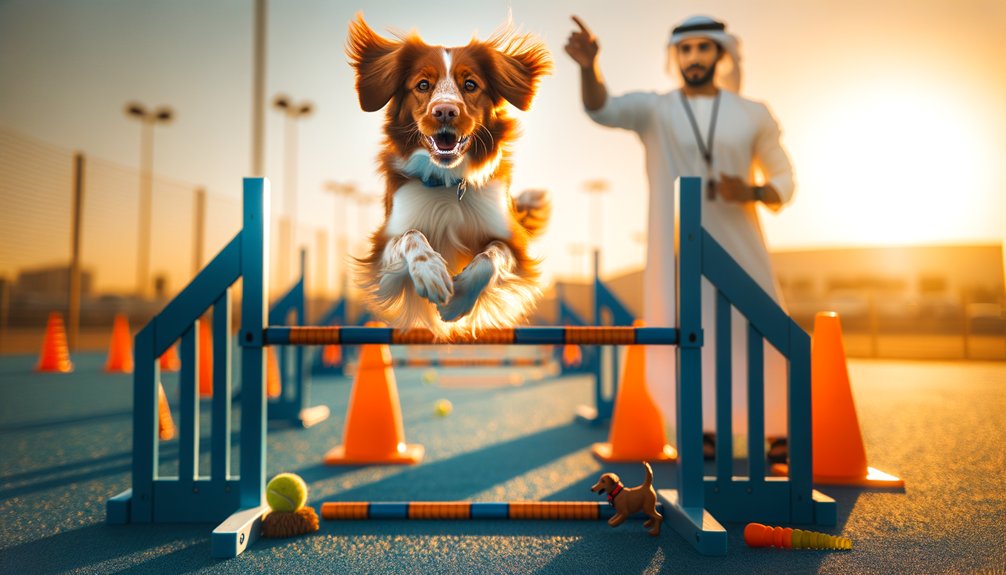“Pawformance: Training Tactics Released” presents a thorough approach to dog training that recognizes the distinct learning styles of individual dogs. By employing positive reinforcement techniques, this program not only cultivates a trusting relationship between dogs and their owners but also promotes effective behavior modification through rewards. In addition, it addresses specific exercises tailored to various breeds, while tackling common training obstacles. Understanding these aspects is essential to enhancing canine training efficacy and fostering a deeper connection. What strategies will prove most effective in this endeavor? Join the journey of transforming your dog’s behavior through positive reinforcement tactics that promise to deepen your bond—discover the secrets within!
Key Takeaways
- Understand your dog’s learning style by observing their reactions to determine if they are visual or auditory learners.
- Utilize positive reinforcement through treats, praise, or playtime to encourage desired behaviors and foster a trusting relationship.
- Tailor training exercises to your dog’s breed, incorporating physical and mental stimulation suitable for their specific needs.
- Establish a distraction-free training environment and maintain consistency to enhance focus and effectiveness during sessions.
- Engage in bonding activities during training to strengthen the connection and build mutual trust with your dog.
Understanding Your Dog’s Learning Style

How can one effectively discern a dog’s unique learning style? Understanding whether a dog is a visual learner or responds better to auditory cues is essential in tailoring training approaches.
Visual learners tend to grasp commands through demonstrations, observing the actions of their handlers, and associating visual stimuli with desired behaviors. In contrast, dogs that rely on auditory cues respond more effectively to vocal commands, tones, and sounds, requiring a nuanced approach to training that emphasizes clear and consistent verbal instructions.
The Power of Positive Reinforcement
Positive reinforcement stands as a powerful tool in the domain of dog training, leveraging the principle that behaviors followed by rewarding outcomes are more likely to be repeated.
This approach aligns with the fundamentals of behavioral psychology, where the use of reward-based methods enhances learning and encourages desirable actions. By offering treats, praise, or playtime as incentives, trainers foster an environment where dogs feel motivated to engage in positive behaviors.
Unlike punitive methods, which can instill fear and anxiety, positive reinforcement promotes a trusting relationship between the dog and trainer. Consequently, this method not only aids in effectively shaping behavior but also empowers dogs with the freedom to explore and express themselves, ultimately leading to a more harmonious companionship.
Engaging Exercises for Every Breed
Engaging exercises tailored to the specific needs of different dog breeds play an essential role in enhancing both physical health and mental stimulation, which are imperative for overall well-being.
Recognizing that not all breeds possess the same energy levels or instincts, owners should incorporate breed-specific activities into their daily routines. For example, herding breeds thrive on tasks that involve agility and problem-solving, while toy breeds may benefit from interactive playtime that focuses on social engagement.
Additionally, larger breeds often require more extensive physical exertion, such as running or hiking, to maintain their fitness.
Common Training Challenges and Solutions
Numerous dog owners encounter a variety of training challenges that can impede their efforts to cultivate a well-behaved companion. Among these obstacles, distraction management and consistency issues frequently arise, complicating the training process.
To effectively address these challenges, the following strategies can be employed:
- Establish a Distraction-Free Zone: Create an area devoid of stimuli that could divert the dog’s attention during training sessions.
- Set Clear Training Goals: Define specific, measurable objectives to maintain focus and direction throughout the training process.
- Implement a Consistent Routine: Regularly schedule training sessions to reinforce learning and establish familiarity for the dog.
- Utilize Positive Reinforcement: Reward desired behaviors to encourage repetition and strengthen the bond between owner and dog.
Building a Lasting Bond Through Training
While training a dog is often seen as a means to achieve obedience and discipline, it also serves as a critical foundation for building a lasting bond between the owner and the pet.
Engaging in bonding activities, such as agility training or scent work, fosters mutual understanding and enhances communication, essential elements in establishing trust. Trust building occurs through consistent and positive interactions during training sessions, allowing the dog to feel secure and valued.
As owners dedicate time to instruct their pets, they create a shared experience that strengthens their connection. Ultimately, training transcends mere compliance, evolving into a partnership characterized by respect and affection, paving the way for a deeper relationship grounded in cooperation and companionship.
Frequently Asked Questions
What Age Is Best to Start Training My Dog?
Determining the best age to start training a dog depends on puppy development stages. Early training fosters positive behaviors, while adult training reinforces learned skills. Both approaches promote freedom and harmony in the human-animal relationship.
How Long Should Training Sessions Last for Effectiveness?
Like a well-tuned instrument, session duration in dog training should ideally last 10 to 15 minutes, with preferable frequency being two to three times daily, ensuring effective learning while keeping the experience enjoyable and engaging.
Can I Train My Dog Without Treats?
Training a dog without treats is possible. Utilizing positive reinforcement techniques, one can explore alternative motivators like praise, play, or toys, fostering a connection that encourages desired behaviors while promoting freedom and joy in training.
What Are Some Signs My Dog Is Bored During Training?
In a world where attention spans rival ancient scrolls, boredom indicators like yawning, disinterest, or distracted behavior emerge. Employing engagement techniques such as varied activities or interactive play can rejuvenate training sessions and enhance focus.
How Often Should I Train My Dog Each Week?
The ideal training frequency varies, but consistency is key. Experts suggest training sessions three to five times a week, allowing flexibility for the dog’s engagement and energy, fostering a joyful and effective learning experience.



